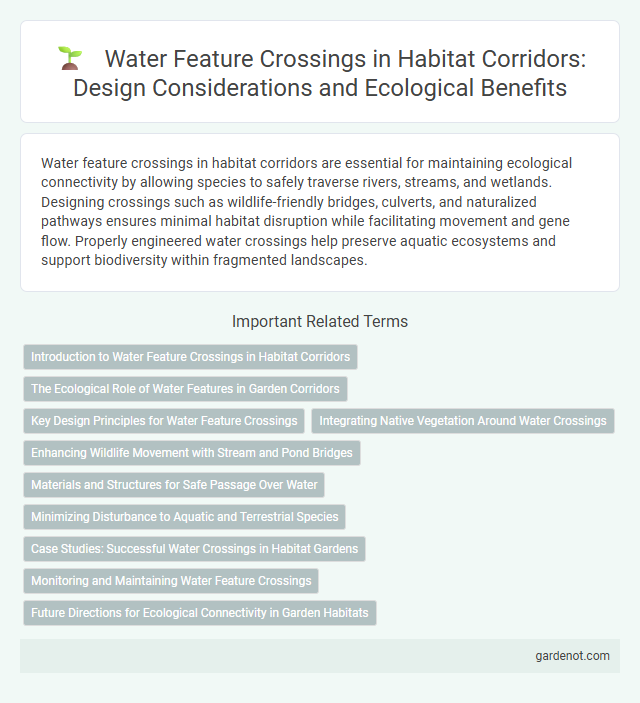Water feature crossings in habitat corridors are essential for maintaining ecological connectivity by allowing species to safely traverse rivers, streams, and wetlands. Designing crossings such as wildlife-friendly bridges, culverts, and naturalized pathways ensures minimal habitat disruption while facilitating movement and gene flow. Properly engineered water crossings help preserve aquatic ecosystems and support biodiversity within fragmented landscapes.
Introduction to Water Feature Crossings in Habitat Corridors
Water feature crossings in habitat corridors are essential structures designed to maintain ecological connectivity by allowing safe passage for wildlife across rivers, streams, and wetlands. These crossings mitigate habitat fragmentation caused by water bodies, supporting species movement and genetic exchange critical for biodiversity conservation. Effective designs include culverts, bridges, and underpasses, which accommodate natural water flow and animal behaviors while minimizing environmental disruption.
The Ecological Role of Water Features in Garden Corridors
Water features in garden corridors serve as critical ecological conduits, enhancing biodiversity by providing essential hydration and habitat for aquatic and terrestrial species. These natural crossings facilitate the movement of amphibians, insects, and small mammals, promoting gene flow and connectivity between fragmented habitats. Incorporating streams, ponds, or wetlands within habitat corridors stabilizes microclimates and supports nutrient cycling, contributing to ecosystem resilience and overall landscape health.
Key Design Principles for Water Feature Crossings
Water feature crossings in habitat corridors must prioritize ecological connectivity by incorporating natural hydrology and minimizing barriers to aquatic and terrestrial wildlife movement. Designs should include permeable substrates, maintain existing water flow regimes, and use vegetated buffers to reduce erosion and pollution. Implementing fish-friendly structures, such as open-bottom culverts or bridges, ensures uninterrupted aquatic habitat and supports biodiversity conservation.
Integrating Native Vegetation Around Water Crossings
Integrating native vegetation around water feature crossings is crucial for maintaining ecological connectivity and supporting local biodiversity within habitat corridors. Native plants stabilize soil, filter pollutants, and provide essential habitat for aquatic and terrestrial species, enhancing the resilience of riparian ecosystems. Strategic planting of indigenous vegetation reduces erosion, improves water quality, and facilitates safe wildlife movement across fragmented landscapes.
Enhancing Wildlife Movement with Stream and Pond Bridges
Stream and pond bridges create uninterrupted water feature crossings, significantly enhancing habitat corridors by allowing safe wildlife movement across aquatic barriers. These structures facilitate connectivity for diverse species, reducing habitat fragmentation and promoting genetic diversity. Incorporating eco-friendly materials and natural design elements ensures minimal disturbance to aquatic ecosystems while supporting terrestrial and amphibious wildlife migration.
Materials and Structures for Safe Passage Over Water
Water feature crossings in habitat corridors require durable materials such as weather-resistant steel, reinforced concrete, and natural stone to ensure longevity and stability. Structures designed for safe passage often include culverts, bridges, and boardwalks that minimize disruption to aquatic ecosystems while providing secure routes for wildlife. Incorporating non-slip surfaces and adequate drainage prevents water accumulation, enhancing safety and habitat connectivity.
Minimizing Disturbance to Aquatic and Terrestrial Species
Water feature crossings in habitat corridors require designs that minimize disturbance to both aquatic and terrestrial species by maintaining natural flow regimes and preserving riparian vegetation. Structures such as wildlife-friendly culverts and bridges ensure unimpeded movement of species while preventing habitat fragmentation and water pollution. Implementing sediment control measures and avoiding excessive noise during construction further protect sensitive ecosystems and promote biodiversity continuity.
Case Studies: Successful Water Crossings in Habitat Gardens
Successful water feature crossings in habitat gardens demonstrate effective integration of wildlife corridors with aquatic systems, ensuring safe passage for amphibians, fish, and other species. Case studies like the green bridge over a restored wetland in Georgia and the fish-friendly culverts in the Pacific Northwest highlight design strategies that balance hydrological flow with ecological connectivity. These projects emphasize the use of natural substrates, gentle slopes, and vegetation buffers to maintain biodiversity and habitat continuity across water barriers.
Monitoring and Maintaining Water Feature Crossings
Effective monitoring of water feature crossings within habitat corridors involves regular inspections using remote sensors and drone technology to detect blockages or structural damage that could impede wildlife movement or water flow. Maintaining these crossings requires prompt removal of debris, reinforcement of bridge supports, and ensuring natural vegetation regrowth to preserve habitat connectivity and aquatic ecosystem health. Data collected from monitoring helps optimize maintenance schedules, enhancing the durability and ecological function of water crossings in landscape connectivity projects.
Future Directions for Ecological Connectivity in Garden Habitats
Innovative water feature crossings such as vegetated culverts and amphibian-friendly tunnels enhance ecological connectivity by allowing safe passage for aquatic and terrestrial species. Integrating bioengineered riparian buffers alongside these crossings fosters habitat continuity and improves water quality. Future garden habitat designs prioritize adaptive, multi-species corridors that respond dynamically to climate change and urbanization pressures.
Water feature crossing Infographic

 gardenot.com
gardenot.com